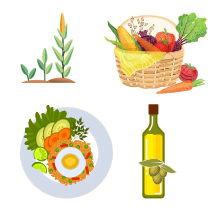A Career in Agriculture
 The biggest factor contributing to the highly efficient agriculture industry that we have today is the advancement of mechanization in the 1900s. New technology significantly reduced the amount of working hours needed for crop production and allowed the small, family farmers to produce a larger yield. Nevertheless, despite all of the evolution in the industry, the basics remain the same; to sow and harvest crops for human consumption.
The biggest factor contributing to the highly efficient agriculture industry that we have today is the advancement of mechanization in the 1900s. New technology significantly reduced the amount of working hours needed for crop production and allowed the small, family farmers to produce a larger yield. Nevertheless, despite all of the evolution in the industry, the basics remain the same; to sow and harvest crops for human consumption.

Agriculture is the primary source of livelihood for about 58% of India’s population. The economic contribution of agriculture to India’s GDP is steadily declining with the country’s broad-based economic growth. Still, agriculture is demographically the broadest economic sector and plays a significant role in the overall socio-economic fabric of India. In fact, the situation was not always like this. Post-independence, India relied on imports and food aids to meet domestic requirements.
However, pioneering work by agriculture scientists and the efforts of farmers, popularly known as the “Green Revolution”, helped achieve a breakthrough in the agriculture sector in the 1960s. The nation that was frequently plagued by famines and chronic food shortage before green revolution, today faces surplus. India is among the top three global producers of many crops, including wheat, rice, pulses, cotton, peanuts, fruits and vegetables. Worldwide, India had the largest herds of buffalo and cattle, is the largest producer of milk and has one of the largest and fastest growing poultry industries. However, unlike developed nations, agriculture still remains the backbone of our country.
Agricultural extension plays a crucial role in boosting agricultural productivity, increasing food security, improving rural livelihoods, and promoting agriculture as an engine of pro-poor economic growth. The role of agricultural extension workers while living among rural people is to bring necessary change in individual and collective behavior and motivating them.
Agricultural extension workers are also the key link between research and farmers. They operate as facilitators and communicators, helping farmers in their decision-making and ensuring that appropriate knowledge is implemented to obtain the best results with regard to sustainable production and general rural development.
They are responsible for:
- Communicating to farmers agricultural information on natural resources, animals, crops, on how best to utilise the farmland, how to construct proper irrigation schemes, the economic use and storage of water, how to combat animal disease, and how to save on the cost of farming equipment and procedures.
- Propagating new farming methods in conjunction with the farmers.
- Researching food, fibre and animal products in conjunction with agricultural scientists.
- Assisting cattle farmers, and veterinary surgeons in the treatment of different animal diseases.
- Encouraging farmers to adopt new, improved methods of farming, using a variety of methods to reach the farmers i.e., organising study groups for farmers, ‘farmer days’, demonstrations, lectures and literature, as well as informing the media.
- Developing recovery programmes for eroded soil, protect cultivated land against erosion and develop a new pasture system.
The agricultural extension worker thus is like a mentor, philosopher, leader, guide and colleague for the community and on the basis of his special qualities he is able to carry out the developmental programme successfully.
| Education Pathway | ||
|---|---|---|
| Undergraduate | Post-Graduate | Some Colleges |
|
B.Sc. (Agriculture) B.Voc.(Agriculture) |
MBA (Rural Development) MBA (Rural Management) M.Voc, (Agriculture) |
|



